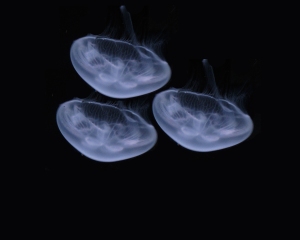Hungry Jellyfish with Empty Stomachs
It’s hard to regulate just how much food to feed your fish sometimes. You don’t want to over feed them or under feed them. But, how do you know if your jellyfish are getting enough to eat each day????? If only you could see just how full they were. Hard to do with fish, BUT….you have jellyfish!!! They’re transparent!
You can see right through them & see their stomachs! This is the best way to know if you’re feeding enough each day to keep them healthy and growing.
One of the most common problems when keeping jellyfish as pets is keeping them nutritionally fulfilled. Most folks are not sure just how much to feed to keep their jellyfish healthy. Jellies are passive feeders and need more food than you think. They quickly become lethargic and thin if they aren’t getting enough good food to eat. So, if you start out not feeding enough nutritional food, your jellyfish will start to wither and shrink.
The picture below represents moon jellyfish that are waiting for a meal. Empty stomachs!
The picture below demonstrates what your jellyfish should look like about 45 minutes after feeding them.
Full Stomachs! Happy Jellyfish!
Their stomachs should be nice and full like this at least once a day, with nutritionally sound food for jellyfish.
A word about vacations, weekends & days off from feeding….
If your jellyfish are healthy and being fed normally and on a regular basis with nutritional jellyfish food, then you can safely get out of town for the weekend. They will be fine given they have full stomachs 5 days out of 7






Will jellies stop eating if they have full stomachs? I am worried about over feeding.
LikeLiked by 1 person
Hi Peter, Since jellyfish don’t have a brain, they don’t know when to stop eating and that’s where the problem starts! Their stomachs can become full of food, but if you keep feeding them, they will continue to take in food because they can’t stop their tentacles from catching it. It’s a natural reaction! Here’s a link to one of our previous blog posts about knowing how much to feed your jellies: https://moonjellyfishblog.com/2015/05/26/jellyfish-feeding/. It’s best to feed them little bits at a time to know when to stop.
LikeLike
Hi guy need some advice about my jellyfish, the bell turning upside down. can anyone help please. thanks.
LikeLike
This looks a useful blog. I’m thinking of getting some jellies, and wondering what people do for longer vacations? Get someone in to feed them? I remember with goldfish we just put a slow-dissolve feeding block in the tank and they were fine, but these sound a lot fussier…
LikeLike
Hi James, sorry we didn’t get back to ya sooner! Typically when people go on vacations, they do have someone to feed them and take care of all necessary maintenance procedures. Jellyfish are a lot more sensitive, so they do need a little more care!
LikeLike
Hi, can jellies skip feeding over the weekends? I’m considering getting some for my office, and wouldn’t be able to feed on weekends. Thanks!
LikeLike
Nevermind, I just read on another post that weekends are fine as long as they are getting fed well the rest of the week… Great blog!!
LikeLike
Yes, they can certainly go over the weekend without food as long as you keep them properly fed & happy the rest of the week.
LikeLike
HI Stephanie–does your jellyfish tank have any kind of substrate on the bottom? If so, that may need to be cleaned as it can hold nitrate producing detritus. Also, take the nitrate reading of your make up saltwater. It should be zero. Depending on your salt mix, it may come with nitrates (some salt mixes do…) and therefore never allow you to eliminate them from your system.
LikeLike
Yes, it has sand on the bottom. Never thought about cleaning the sand–I’ll try that too. My saltwater has a “0” nitrate reading, so I think that’s ok. Thanks for the tips!
LikeLike
Hi! Thanks for your jelly info–it’s helped a lot in getting my blue blubber going. I’m wondering how much you actually feed your jellies in terms of a concrete measurement. My blue blub is translucent at best, so I can’t see its stomachs. Its shrinking, but my nitrite/ammonia levels are close to zero, so tank is close to cycling. Any suggestions?
LikeLike
Hi Stephanie–your jelly will eat better once the tank is fully cycled. Traces of ammonia and nitrite are toxic and can inhibit the jelly from eating. What are you feeding now? About how much of it and to what size jellyfish tank?
As for portion size once you do get it fully cycled…we feed 6 jellyfish (2″ diameter) in the 10 gallon Eon Jellyfish tank 1.25g of our Frozen Jellyfish Food per day.
LikeLike
Hi! thanks for responding. I’m feeding one jellyfish that’s about 1.5″ in diameter about 1/2 tab of frozen brine shrimp (36 tabs = 1.75 ounces or 50 grams) or 1/3 cap full of Reef brand zooplankton once a day (maybe 1/4 teaspoon?). This is going into a 3 gallon tank. Sounds like I’m feeding it too much of the brine shrimp, if I’m doing the math right.
My current problem is that my nitrite and ammonia levels are down to zero, but my nitrates are skyrocketing, despite daily water changes for a week: 25-40% of the water. They were at 40 ppm when I sent you the last comment, now they’re at 160 ppm plus. I just changed the filter and added a nitrate remover as well. Jelly is losing mass. Any insight would be appreciated. Thanks!
LikeLike